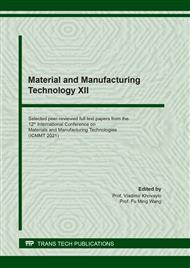p.3
p.15
p.21
p.29
p.39
p.45
p.51
p.57
Study of Micro-Upsetting by Finite Element Simulation Based on Crystal Plasticity and Grain Boundary Strengthening Theories
Abstract:
The properties of individual grains affect the mechanical behaviors and response of materials in micro-scaled deformation, viz., microforming, and there are unknown phenomena and deformation behaviors existing and limiting the wide application of microforming due to size effect. In this paper, a composite model combining crystal plasticity and grain boundary strengthening theories was developed for numerical investigation into the effect of grain boundaries on the plastic deformation of copper micro-upsetting. By comparing the results with and without grain-boundary structure, it is revealed that grain boundaries, which act as the barriers of crystal slip, result in the enhanced flow stress and the discontinuous distribution of stress and strain. The grain size effect is also considered in this research, and the results show the coarse-grained material reduces the flow stress and enhances the inhomogeneous deformation.
Info:
Periodical:
Pages:
21-28
Citation:
Online since:
August 2021
Authors:
Price:
Сopyright:
© 2021 Trans Tech Publications Ltd. All Rights Reserved
Share:
Citation:


